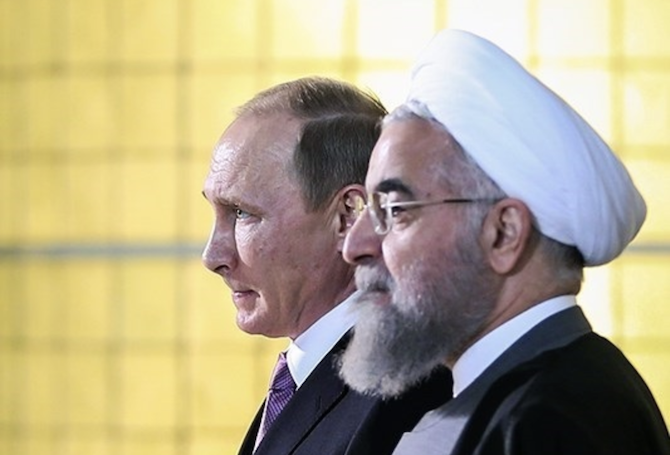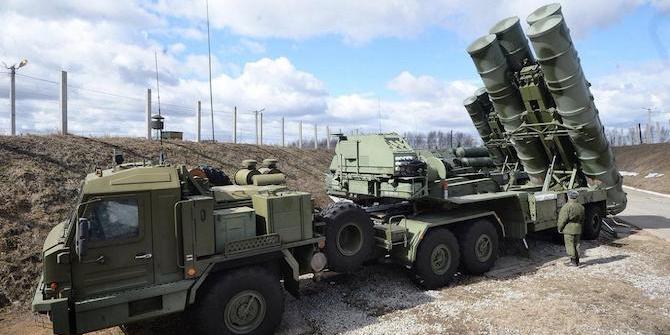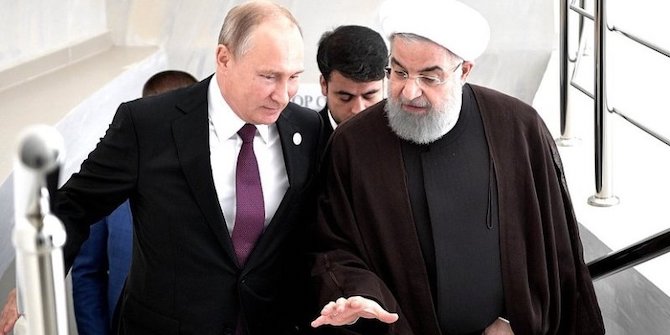by Ghoncheh Tazmini

Vacillating between cooperation and contention, the Russian–Iranian partnership has long been riddled with contradictions. For scholars, Moscow’s mercurial manoeuvrings have made it challenging to decipher the nature of the partnership. One Iranian analyst qualified Moscow’s interactions with Tehran as a ‘run with the hare, hunt with hounds’ approach. Following its ‘zigzagging’ trajectory, he argued that the degree of expansion or contraction in Russian–Iranian cooperation depended on whether relations between the US and Russia were amicable or hostile at the time.
Evidence of this was the construction of the Bushehr power plant and the delivery of the sale of Russian-made S-300 surface-to-air missile systems. Russia stalled for years, especially during Russian President Dmitri Medvedev and US President Barack Obama’s dalliance with the idea of a ‘reset’ in relations. What was underplayed was the fact that while Russia delayed, it did deliver in the end. This point cannot be emphasised enough – for an isolated Iran, with more foes than friends, what ultimately mattered was that (some) of its needs were being met. In the end, Russia delivered on its matrimonial promises.
Curiously, the Russian–Iranian partnership has proven to be steady. What explains the durability of the partnership despite conflicting interests in different geopolitical theatres? Syria, for example, is regularly singled out as the arena in which the Russian–Iranian partnership is bound to unravel. Tehran and the Kremlin are aligned in that they both support Bashar al-Assad’s leadership, but they pursue very different approaches when it comes to post-conflict Syrian governance, state-building and military reform.
In fact, tensions have been brewing for years over reconstruction and investment opportunities. Vying over lucrative government contracts, both states expect dividends. ‘We have probably paid $20–30 billion to Syria, and we have to take that money back’, Heshmatollah Falahatpisheh, a member of the Iranian parliament’s national security committee said in an interview with the state-run news website Etemad Online.
There was also speculation that tensions would flare up between the two states when on 8 July, Iran and Syria signed a bilateral pact to strengthen military and defence cooperation. Analysts were quick to predict that the Iranian military deployment (two batteries of surface-to-air missiles) authorised in the military deal would challenge the partnership.
However, as long-term patterns of engagement suggest, the Russian–Iranian partnership will likely pass this litmus test as it has others. Iranian analyst, Shuaib Bahman, corroborates this view. Speaking to the Mehr News Agency, he explained that although Russia and Iran have disagreements over Syria, they are not competitors. Bahman maintains that that while other actors and coalitions in Syria, including Turkey, Qatar, Egypt, the United Arab Emirates, Saudi Arabia and the US have disbanded over discrepancies and disputes, Tehran and Moscow have been able to successfully manage their differences in Syria. Russia and Iran, he argues, will continue cooperating in Syria and beyond.
In the past month alone, Tehran and the Kremlin have reaffirmed their commitment to bilateral cooperation in several ways. On 20 July, Iranian Foreign Minister, Javad Zarif, who visited Moscow for the third time in six months, confirmed that Tehran was planning to extend a 20-year agreement with Russia. The agreement is set to expire in March 2021. In turn, Moscow expressed its willingness to help Iran complete work on their nuclear power plant. On 2 August, Zarif reaffirmed to Leonid Slutsky, Chairman of the International Affairs Committee of Russia’s State Duma, Iran’s readiness to ramp up parliamentary relations to a strategic level. Russia recently came to Iran’s defence in the UNSC over the controversial vote over the Iranian arms embargo. On 14 August, Russian President, Vladimir Putin proposed a seven-way online summit of UNSC permanent members, along with Germany and Iran, in a bid to avoid ‘confrontation and escalation’ at the UN. The US lost the bid to extend a UN arms embargo, set to expire on October 2020.
How can we explain the durability of the partnership despite ups and downs, clashes and discord? In my research, I have identified a unique ideational synergy binding Moscow and Tehran despite asymmetrical approaches and conflicting interests. Both states espouse a similar political logic and understanding of the international system. This shared geopolitical vision has developed organically along deeper lines of convergence, including civilisational peculiarities, historical experiences, normative values and social identities, cultural orientations, and a similar discursive genealogy in relation to the West.
While Russia and Iran may clash in different regional theatres, their alignment is buttressed by several ideational pillars. Russia and Iran are both anti-hegemonic, opposing the idea of a single state or a constellation of states being able to impose particular normative values and power structures as universal. Both states have demonstrated a commitment to building alternative integrative networks, and multilateral institutions on a regional level in order to create a counterweight to US unipolarity (the Shanghai Cooperation Council, the Eurasian Economic Union, or Iran’s recent 25-year agreement with China, for instance). Both have a common security threat perception, strongly opposing the universalist normative aspirations of the international system, which they deem as a threat to their unique civilisational identities.
Moscow, in particular, opposes the US-led Atlantic ideological and power systems that gained traction at the end of the Cold War, when Russia and the West entered the era of ‘Cold Peace’. As a countermeasure, Russia’s overriding strategic goal has been to advance what Trine Flockhart refers to as a ‘multi-order’ in which different ‘inter-orders’ of sovereign states are nested within an overall international system. In this pursuit, Tehran has been a reliable partner. Iran and Russia are firmly ensconced as an ‘inter-order’ within this emerging ‘multi-order’ international system.
In order to better understand the paradoxes and contradictions of this partnership, it is useful to conceptualise two separate levels that define Moscow–Tehran relations: on the top plane there are both common or clashing realpolitik interests that are held down by a gravitational pull onto a foundational level, comprised of common principles and perceptions of the international system. It is this crucial foundational level that accounts for the paradoxes of this most peculiar, but permanent, partnership.







1 Comments